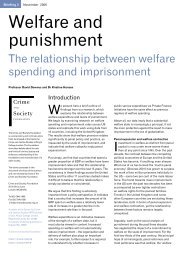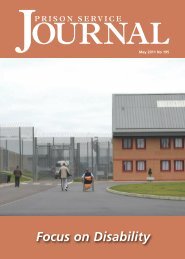PRISON SERVICE
PRISON SERVICE
PRISON SERVICE
- No tags were found...
You also want an ePaper? Increase the reach of your titles
YUMPU automatically turns print PDFs into web optimized ePapers that Google loves.
elationships that exist in prison healthcare settings. Suchdemands include ensuring that the prisoner feelsconfident in the nurse’s ability or the prison officer feelingthat the nurse understands the officer’s perspective, or theprison’s routine restricting the nurse’s ability to provideparticular or appropriate care. In Walsh’s study, nurses alsonoted stresses inherent in managing aggression andmanipulation, coping with prisoners whose offenses theyfound difficult to deal with emotionally, workingalongside colleagues whose practice was felt to besubstandard, and managing relationships with prisonofficer colleagues. Some described using detachment as away of avoiding sympathy, empathy and care forprisoners. These data suggest that conflicting professionalideologies, sometimes combined with a relative lack ofpower in the prison structure, maytake a higher toll in job-relatedstress on health care personnel inprisons.A second stress-producingaspect of the job for correctionsofficers is the need to deal withviolent and disruptive inmates 9 .Parker designed and evaluated atraining course for correctionalofficers in a ‘supermax’ facility(designed for violent or disruptiveinmates). The course was designedon the premise that correctionalstaff had received only minimalprior training for managing suchinmates, and for understandingmental health issues. The 10-hourcourse was designed and taughtby the National Alliance on MentalIllness especially for correctionalstaff and focused on the specificconditions that correctionalofficers faced. Compared with the nine months beforethe course, incidents of assault by bodily waste (the socalled‘prison officer cocktail’) on officers by inmates inthe unit after the course declined significantly to zero, andall incidents involving officers also significantly declined.Parker 8 suggests that this was as a result of trainingcorrectional officers to better understand and deal withmentally ill offenders, including talking with offenders ina therapeutic manner, and working as an integral part ofthe mental health diagnosis and treatment process. Thisnot only reduced violence against officers throughproviding officers with a better understanding of how toThe prison’s physicaland organizationalenvironment itselfmay account for aconsiderable amountof stress and poorhealth in workers inthe system — bothcorrectional officersand correctionalhealth andtreatment personnel.deal with the mentally disturbed, but also reduced thestress of working with difficult and potentially violentoffenders. Thus, some workplace stressors are open toreduction through appropriate training and interventionprograms. Further, Parker’s data also confirm the closeinteractions between the adequacy of officers’ trainingand prisoners’ behaviour in stressful situations.Organizational environment and StressThe prison’s physical and organizational environmentitself may account for a considerable amount of stress andpoor health in workers in the system — both correctionalofficers and correctional health and treatment personnel.In a landmark study of predictors of stress in bothcorrectional officers and treatmentpersonnel in the Arizona prisonsystem, Armstrong and Griffin 10found that correctional officersand prison treatment staff scoredsimilarly on measures of stress andon stress-related health problems(including headaches, fatigue, andstomach trouble). High workplacestress (disturbance of physiological,psychological or social functioningin response to a condition in thework environment which poses athreat to well-being or safety) isexperienced by large numbers ofcorrectional staff (39 per centaccording to Lindquist andWhitehead 11 in their 1986 study)and may be associated with acombination of factors such as thecorrectional environment itself andlow pay and lack of benefits. Oneof the results of these highstressors is high staff turnover rates, itself contributing tounderstaffing and lower levels of training. The interactionof stress, staffing levels and training levels can lead to avicious cycle of understaffing, stress, high turnover andlower levels of training and experience.One of the organizational factors that Armstrongand Griffin 12 suggest lead to stress is the shift in the UStoward viewing correctional institutions as primarilypunitive rather than rehabilitative. Shifts in institutionalpurpose can lead to a lack of clarity about role, jobobjectives, and responsibilities, lack of support fromsuperiors, and lack of consistency in instructions and9. Parker GF (2009). Impact of a mental health training course for correctional officers on a special housing unit. Psychiatric Services60:640-645.10. Armstrong GS, Griffin ML (2004). See n.4.11. Lindquist CA, Whitehead JT (1986). Burnout, job stress and job satisfaction among southern correctional officers: Perception and causalfactors. Journal of Offender Counseling, Services and Rehabilitation 10(4):5-26.12. Armstrong GS, Griffin ML (2004). See n.4.Issue 192 Prison Service Journal57











